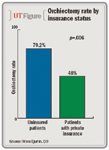Article
Orchiectomy rate linked to race, insurance status
Patients with severe testicular trauma typically face two treatment options: orchiectomy or orchidorrhaphy. A new analysis of national trauma reports suggests that race and insurance status, rather than geography, type of trauma, severity of injury, or other factors, play key roles in decisions that lead to excision or salvage of a damaged testis.

Key Points
San Francisco-Patients with severe testicular trauma typically face two treatment options: orchiectomy or orchidorrhaphy. A new analysis of national trauma reports suggests that race and insurance status, rather than geography, type of trauma, severity of injury, or other factors, play key roles in decisions that lead to excision or salvage of a damaged testis.
"There is a growing recognition of the disparities in health outcomes in America," said first author Marc Bjurlin, DO, urology resident at Cook County Hospital, Chicago. "But there is little evidence about disparities in testicular salvage. We decided to find out how different factors may impact care following testicular trauma."
Race, ethnicity, geography, and insurance status are widely recognized as factors that can contribute to disparities in access to medical care, the quality of care provided, and the outcomes of care, Dr. Bjurlin noted during a presentation at the 2011 American College of Surgeons Clinical Congress in San Francisco. African-Americans, Hispanics, and the uninsured generally have higher rates of hospitalization, worse clinical outcomes, and higher mortality rates than other groups. But it is unknown whether there are race, insurance, or geographic disparities in testicular salvage rates following testicular trauma.
The database showed that of patients with mechanical injury to the genitourinary region, 46% had blunt injury, 48% had penetrating injury, and 6% were unspecified. Among patients who eventually underwent orchiectomy, 71% had penetrating injury, 25% had blunt injury, and 4% had an unspecified injury type. Among patients who had testicular salvage, 47% had penetrating injury, 47% had blunt injury, and 3% had an unspecified injury.
The researchers could not evaluate the length of time between injury and admission, transport time, or other delays that might affect treatment decisions or outcomes, noted Dr. Bjurlin, who worked on the study with Courtney M. Hollowell, MD, and colleagues.
The 169 patients who had either orchiectomy or orchidorrhaphy were evaluated based on payer type, race, ethnicity, age, rural location, injury severity score, length of hospital stay, length of ICU stay, and number of days on ventilator support, Dr. Bjurlin reported. Univariate analysis found that just two factors-payer type and race-were associated with higher rates of orchiectomy.
Disparities by insurance status, race seen

There was no statistically significant difference in orchiectomy rates between Hispanics and non-Hispanics: 68% vs. 65.8% (p=.84).
There were also no statistically significant differences in orchiectomy versus orchidorrhaphy based on rural or urban location, age, injury severity score, total length of hospital stay, length of ICU stay, or ventilator days. The authors performed a subsequent subset analysis evaluating the trauma level of the hospital of treatment (level 1 and 2) as a surrogate of surgeons who may adhere to trauma guidelines, which did not reveal any statistical differences (p=.10). Furthermore, even though more African-Americans were uninsured, the differences in mechanism of injury did not account for the payer type and racial disparities (p=.46).
The reasons for disparities based on payer type and racial disparities are not clear, Dr. Bjurlin said, and neither factor emerged as a predictor of orchiectomy on multivariate analysis.
"It is clear that additional efforts are needed to reduce these disparities," he said. "We theorize that standard protocols for the management of testicular injuries might help reduce disparities."














